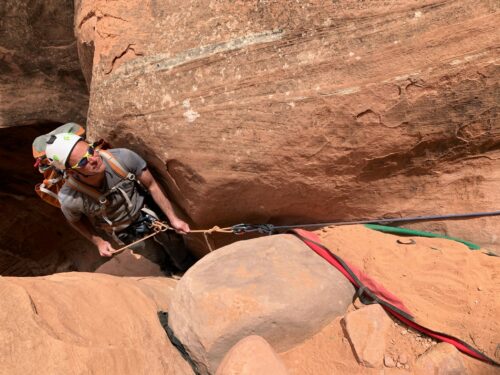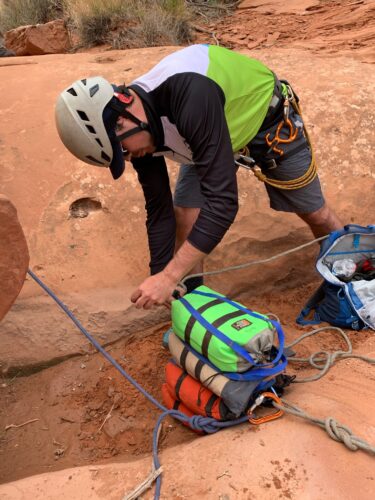7 Advanced Canyoneering Anchors To Add To Your Toolkit
Are you eager to take your canyoneering skills to the next level? Canyoneering in the Southwest offers great potential for those seeking a unique adventure. However, exploring some of the most extraordinary off-the-beaten-path canyons requires a skillset beyond basic canyoneering techniques. Adding advanced canyoneering anchors to your toolbox can be an invaluable asset that allows you to travel deeper and more safely into the wild.
Basic canyoneering rigging techniques may involve a locked off rappel device attached to a set of bolts or a large boulder. By comparison, advanced canyoneering anchors are strategically constructed from other resources that range from something as simple as a bag of sand to more complex such as a series of hitches that release upon tensioning the ‘pull’ side of the rope. Successful implementation of advanced canyoneering anchors requires proficiency in advanced canyoneering rigging techniques, but also extends to proper sequencing within the team, ability to rappel smoothly and consistently, and effective methods of retrieval.

Here are three benefits of deploying advanced canyoneering anchors:
1) Expanding your skillset to explore new canyons. In many wilderness areas bolting is prohibited. Therefore, lacking a heavy boulder or deep-rooted tree, advanced canyoneering anchor skills may be required to explore certain canyons. Learning advanced anchors enables canyoneers to push their exploration to new limits.
2) Canyons are dynamic environments. Picture your favorite slot canyon and the series of anchors for each rappel. During a flood event, a torrent of water is violently thrashing car sized boulders through the canyon system. If you were to return to this canyon after such a flood, and the tree or boulder anchor you depended on was nowhere to be found, would you be able to continue through the canyon? Advanced anchors help canyoneers be more prepared by providing a suite of options to quickly adapt to unexpected conditions.
3) Leave No Trace. You may have heard canyoneers talk about ‘ghosting’ a canyon, meaning that they left no sign they were ever there (i.e., no quick links, no webbing, and no rope grooves). This style of canyoneering is preferred by some as it aligns with Leave No Trace principles. Advanced canyoneering anchors employ retrievable techniques to limit the gear left in the canyon and reduce environmental degradation.
Seven common advanced canyoneering anchors include:
The Fiddle Stick
This is a type of toggle anchor that involves tying a Marlin Spike knot (or a Stone knot) around a device called a fiddle stick (~8 inch plastic stick with a pull cord tied to one end). While the fiddle stick is in place, the group can safely rappel. After the last person rappels, the pull cord is used to retrieve the fiddle stick and the hitch is released.
The Macramé
This technique consists of pulling a bite of rope around a tree or stone pillar (i.e., no need for webbing or quick link), then alternating bites of rope from the rappel side through the pull side and vice versa. The Macramé knot allows the team to rappel safely and after the last rappeler, the rope is retrieved by tensioning the pull side of the rope.
The CEM
This knot is similar to a Macramé style retrievable anchor. It involves a series of knots that can support a rappeler on one side of the rope. Once the group has all rappelled, the other side of the rope is pulled which releases the CEM knot and retrieves the rope.

The Sand Trap
This innovative technique incorporates a long oval piece of canvas material that is specifically designed for canyoneers to load with sand. When the sand trap is appropriately weighted, the group rappels on this anchor. A second rope tied to the far end of the sand trap is then pulled to dump out the sand and retrieve the sand trap.
The Water Anchor (W’Anchor)
This advanced anchor is a close cousin to the sand trap, but relies on a water filled bag designed specifically for the canyons as the anchor. The back of the water anchor has a roll top to seal the bag and is held shut by a pin. Once the group rappels on the anchor, a pull cord is used to remove the pin, thereby releasing the water and the empty W’Anchor is pulled down.

The Pot Shot
Often used in a series, pot shots are small bags filled with sand and stacked to form an anchor for a rappel (or thrown to escape a pothole). The pot shots are all tied in a specific order on a pull cord so that, after the team rappels, the pot shots are pulled one at a time down canyon and each empties its sand as the pot shot passes over the lip.
The Pack Drag
As one of the original canyoneering anchor techniques, this advanced method is used to support a hand line during a short down climb. Pack drags are also a useful tool to escape potholes by throwing a pack attached to a rope out of the pothole. The rope can then be used to climb out of the pothole and retrieve the pack.
When you know how to utilize and apply these advanced canyoneering anchors, it provides you with the confidence that you can overcome the obstacles you will encounter in the canyon as well as expand the list of canyons that you have the skill set to explore. If you are ready to elevate your canyoneering skills, the Get In The Wild team invites you to join us for our Advanced Anchors and Rigging Course where expert instructors will help you develop a robust and comprehensive canyoneering anchor toolkit for your canyoneering adventures.